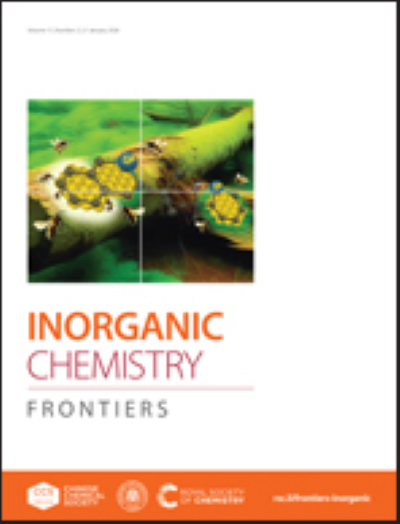低价钽/金团簇:氧化、质子化和碳氢活化
IF 6.1
1区 化学
Q1 CHEMISTRY, INORGANIC & NUCLEAR
引用次数: 0
摘要
金基催化剂是热门的异质分子物种,其化学多样性可通过掺杂杂金属得到扩展。在这里,我们利用无羰基金属-金属盐偏析协议,获得了低价钽/金多金属的罕见实例。Ta(萘)3]- 和金(I)合成物之间的初始反应生成了三金属一氢簇(2)。向 2 中加入二氢会导致脱氢,生成 Ta-µH2-Au 复合物(1),而氧化转化--无论是加入化学氧化剂还是簇质子化--都会保留三金属内核,甚至在没有多核配体的情况下也是如此。由此产生的一系列化合物为计算极化金属与金属之间的相互作用提供了实验基础,这种相互作用是金属特性、形式氧化态和配体球的函数。即使在氧化态较高的情况下,这些团簇的电子结构也显示出明显的钽烯共价性,从而证明了配体取代的不稳定性。此外,将原位生成的 Au+ 添加到 2 中会导致炔 C-H 活化过程,这突出表明这些复合物中的萘配体同时具有取代惰性和易官能化性。本文章由计算机程序翻译,如有差异,请以英文原文为准。
Low-Valent Tantalum/Gold Clusters: Oxidation, Protonation, and C–H Activation
Gold-based catalysts are topical heterogeneous and molecular species, the chemical diversity of which can be expanded through heterometal doping. Herein, we leverage a carbonyl-free metal-metal salt metathesis protocol to access rare examples of low-valent tantalum/gold multimetallics. The initial reaction between [Ta(naphthalene)3]– and gold(I) synthons affords a trimetallic monohydride cluster (2). Whereas dihydrogen addition to 2 results in deauration en route to a Ta-µH2-Au complex (1), oxidative transformations—either addition of chemical oxidants or cluster protonation—conserve the trimetallic core, even in the absence of a polynucleating ligand. The resultant series of compounds provide experimental anchors for computational interrogation of polarized metal-metal interactions as a function of metal identity, formal oxidation state, and ligand sphere. The electronic structure of these clusters showcases significant Ta-arene covalency, even at higher oxidation states, rationalizing a recalcitrance to undergo ligand substitution. Furthermore, the addition of in situ generated Au+ to2 results in an arene C–H activation process, highlighting that the naphthalene ligands in these complexes are simultaneously substitutionally inert and prone to functionalization.
求助全文
通过发布文献求助,成功后即可免费获取论文全文。
去求助
来源期刊

Inorganic Chemistry Frontiers
CHEMISTRY, INORGANIC & NUCLEAR-
CiteScore
10.40
自引率
7.10%
发文量
587
审稿时长
1.2 months
期刊介绍:
The international, high quality journal for interdisciplinary research between inorganic chemistry and related subjects
 求助内容:
求助内容: 应助结果提醒方式:
应助结果提醒方式:


